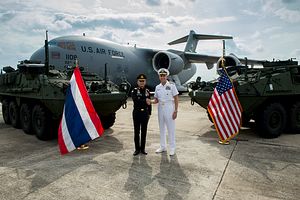Last week, a formal announcement was disclosed about Thailand receiving the first batch of a delivery of new military vehicles from the United States. While the delivery represented just the latest step in the advancement of a previously concluded defense deal between the two treaty allies, it nonetheless spotlighted the development of security ties between them within their broader relationship.
As I have noted before, the United States and Thailand have a range of engagements in the defense side of their relationship as part of their wider ties. This includes not only bilateral components that are usual in relationships such as visits, exchanges, and arms sales, but also multilateral exercises such as Cobra Gold and periodic access for the U.S. military during regional contingencies. That has continued on despite some shifts in recent years, including Thailand’s navigation of its post-May 2014 coup environment and the election of U.S. President Donald Trump and the changes that have resulted in U.S. Asia defense policy.
One of the developments that had been in the headlines in this respect was Thailand’s purchase of Stryker infantry carrier vehicles. Following some indications of a deal earlier in the year, we received a formal announcement of the approval of a foreign military sale to Thailand for Stryker infantry carrier vehicles from the Defense Security Cooperation Agency on July 26 for 60 Strykers and supporting equipment for an estimated cost of $175 million.
While the advancement of security collaboration between the two treaty allies was in and of itself not surprising, it had been viewed in relation to other questions, including the extent to which defense collaboration would be advanced and the inroads Washington was making relative to those of China. Indications were that the ICVs would begin to be delivered later in 2019, with the Strykers expected to be sent to the 11th Infantry Division, which is based in Chachoengsao.
Last week, the deal was in focus again with the delivery of the first batch of ICVs to the Thai military. According to the Joint U.S. Military Advisory Group Thailand (JUSMAGTHAI) in a social media announcement on its Facebook Page on August 29, the first batch of ICVs were delivered to the Royal Thai Army (RTA). The JUSGAGTHAI announcement was accompanied by images which showed the ICVs being flown in by a U.S. Air Force transport aircraft and several Thai and U.S. officials being present at the handover, including U.S. Navy Admiral Philip Davidson who is now the commander of the U.S. Indo Pacific Command (USINDOPACOM).
Per USINDOPACOM via its Twitter account, two Strykers had been delivered as part of the first batch that was delivered to the RTA. The delivery also came amid other developments in U.S.-Thai relations, including the holding of this year’s iteration of the Indo Pacific Chief of Defense (CHODS) conference, which was jointly hosted by USINDOPACOM and the Royal Thai Armed Forces (RTAF) from August 26 to 28 which Davidson participated in as well.
































